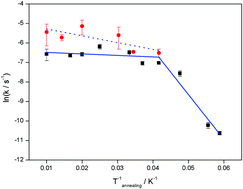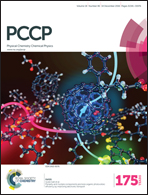Peeling the astronomical onion†
Abstract
Water ice is the most abundant solid in the Universe. Understanding the formation, structure and multiplicity of physicochemical roles for water ice in the cold, dense interstellar environments in which it is predominantly observed is a crucial quest for astrochemistry as these are regions active in star and planet formation. Intuitively, we would expect the mobility of water molecules deposited or synthesised on dust grain surfaces at temperatures below 50 K to be very limited. This work delves into the thermally-activated mobility of H2O molecules on model interstellar grain surfaces. The energy required to initiate this process is studied by reflection–absorption infrared spectroscopy of small quantities of water on amorphous silica and highly oriented pyrolytic graphite surfaces as the surface is annealed. Strongly non-Arrhenius behaviour is observed with an activation energy of 2 kJ mol−1 on the silica surface below 25 K and 0 kJ mol−1 on both surfaces between 25 and 100 K. The astrophysical implication of these results is that on timescales shorter than that estimated for the formation of a complete monolayer of water ice on a grain, aggregation of water ice will result in a non-uniform coating of water, hence leaving bare grain surface exposed. Other molecules can thus be formed or adsorbed on this bare surface.


 Please wait while we load your content...
Please wait while we load your content...